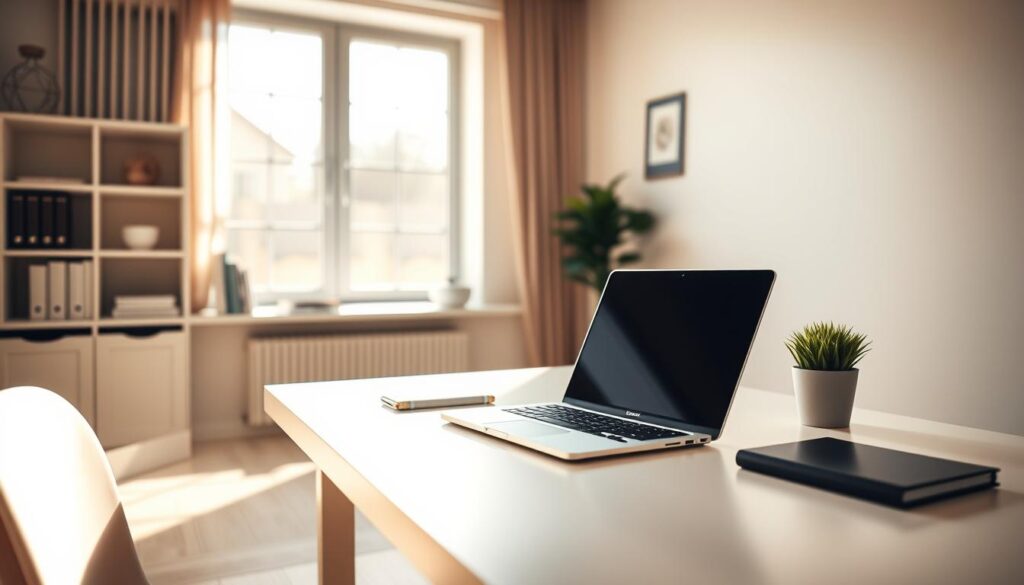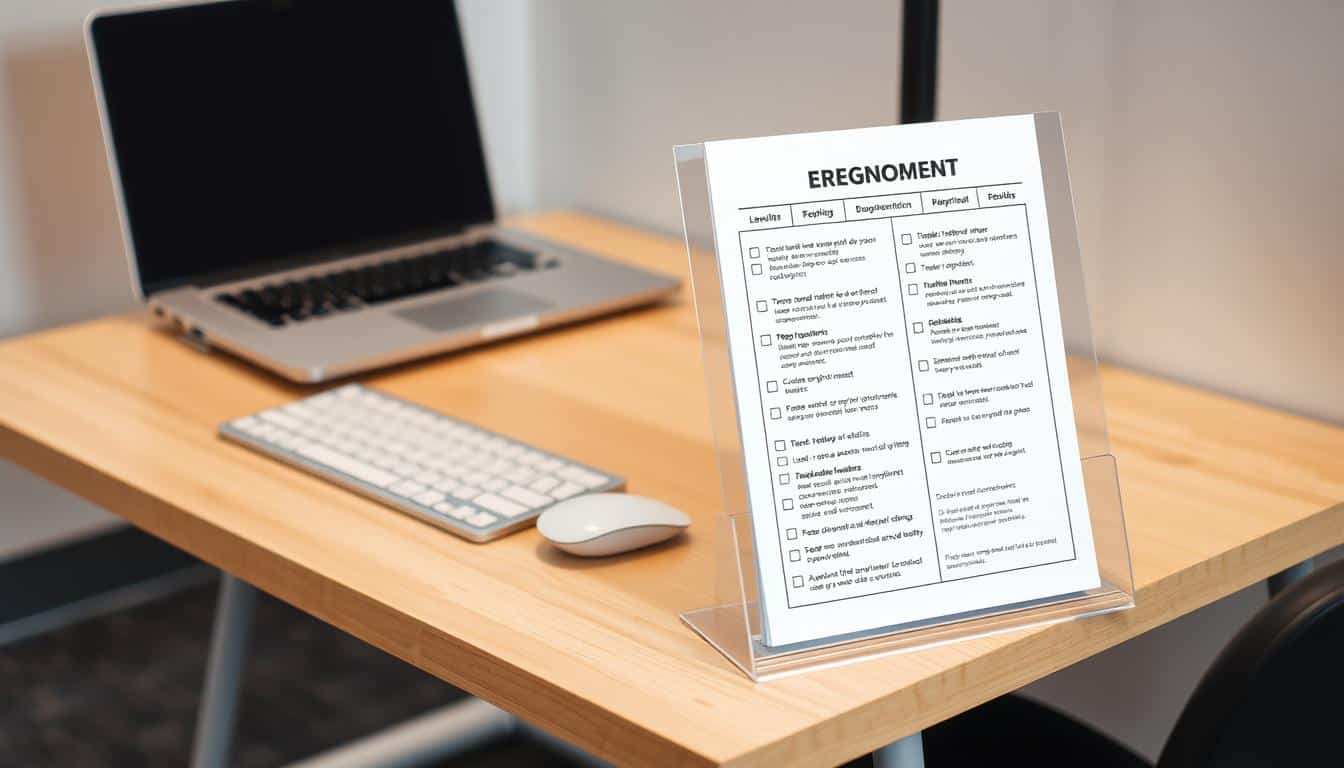Creating a minimalist ergonomic home office boosts productivity at home. A well-optimized workspace increases efficiency and looks good. This article explores how to create an effective ergonomic setup. It covers choosing the right furniture to adding personal touches. By keeping only what you need and removing clutter, you turn your home office into a productivity center.
Understanding the Importance of a Minimalist Workspace
Today’s busy world highlights the need for a minimalist workspace. Reducing clutter is key to enhancing focus during work. This creates a setting that boosts creativity and work efficiency.
Homes cluttered with unwanted items distract us and slow us down. Studies show that a clean space improves our ability to think clearly. By choosing minimalism, we focus on what truly matters.
Begin by evaluating what you own, removing what you don’t need. A space with fewer distractions not only increases productivity but also promotes a sense of calm and effectiveness.

Benefits of an Ergonomic Home Office Setup
An ergonomic home office setup boosts comfort and productivity. It’s key to focus on office health to cut risks tied to long sitting periods. Aligning your office with your body’s natural shape improves posture. It also lessens back and neck pain.
Applying ergonomic tips leads to less back pain and better blood flow. This setup matches the spine’s curve, which cuts down on tiredness. Plus, it boosts work productivity. As energy goes up, so does work quality. This means more work done with fewer sick days.
Setting up an ergonomic workspace enhances work performance over time. Putting effort and resources into an ergonomic office pays off. It creates a healthier, more efficient work life.
Key Elements of a Minimalist Ergonomic Home Office
To create a minimalist ergonomic home office, knowing the key parts is vital for comfort and function. A good desk is central, making it easy to switch between sitting and standing. An adjustable desk helps in staying active and lessens tiredness.
An ergonomic chair is key for keeping a healthy posture. It should let you change its height, support your lower back, and fit your sitting. These features boost comfort and help avoid pain during long work hours.
Setting your monitor right is crucial for keeping your posture right and eyes healthy. Place the monitor at eye level to keep your neck comfy and eyes rested. Good lighting is also key, as it reduces eye strain and helps you focus better while working.
Keeping your workspace neat adds to the minimalist look. Using smart cable management keeps your area clean and helps you stay focused by removing mess.
Choosing the Right Desk for Your Needs
Choosing the right desk is key to setting up a minimalist, ergonomic home office. It’s important to know the differences between adjustable and fixed desks. They can greatly affect your productivity and comfort. A good desk supports a healthy posture and makes you more efficient all day.
Adjustable Desks for Flexibility
Adjustable desks let you move from sitting to standing whenever you want. This choice suits different people and working styles well. They offer major benefits:
- Reduced health risks linked to prolonged sitting
- Enhanced comfort tailored to individual needs
- Increased energy levels throughout the day
Fixed Desks and Their Benefits
Fixed desks have a consistent height and focus on looks. They often provide storage solutions too. Here are their main perks:
- Consistent work surface height
- Stylish designs that complement home decor
- Usually more affordable due to simpler mechanisms
When choosing between adjustable and fixed desks, think about ergonomics. Pick a desk that lets you keep your arms level with the floor. And, make sure there’s enough room for your legs to be comfortable.
Selecting an Ergonomic Chair
An ergonomic chair is key for comfort at work, especially when sitting for long hours. It helps keep your posture right, reduces tiredness, and boosts how well you work. Knowing what makes a chair ergonomic is important for picking the best one.
Features to Look for in an Ergonomic Chair
You should look for these important features:
- Adjustable height to fit your desk and what feels best for you
- Lumbar support that keeps your spine’s natural shape
- Armrests you can adjust to take pressure off your shoulders
- Enough seat depth for comfort, leaving space between the chair’s edge and your knees
These features make sure you get the best support and comfort at your desk.
Testing the Comfort Level Before Purchase
Try out the chair for at least 30 minutes before you decide. This lets you see if it fits well with your body and likes. A good chair supports a healthy posture and cuts down on discomfort from sitting too long. Check how the chair adjusts and see which settings feel best for you.
Optimizing Monitor Placement for Better Posture
Putting your monitor in the right spot is key for a comfy and productive workspace. It helps you sit properly and avoid eye strain. By adjusting your monitor correctly, you can work longer without feeling bad.
Ideal Height and Distance from Eyes
Your monitor should be at or just below eye level. It’s best about 20 to 40 inches from your eyes. This keeps your head straight and prevents neck pain. Make sure to adjust your monitor for your comfort and better work output.
Avoiding Glare and Eye Strain
Keep your monitor away from windows to reduce glare. Match your screen brightness with the room light. Also, take breaks regularly. Try the 20-20-20 rule: every 20 minutes, look at something 20 feet away for 20 seconds. This helps keep your eyes healthy and prevents strain.
Essential Accessories for Ergonomic Support
Having the right desk and chair is just the start for an ergonomic workspace. You also need things like monitor stands and arms. They make sure your screen is at the best height. This helps prevent neck and eye pain and helps you sit properly when working for a long time.
Monitor Stands and Arms
Monitor arms give you the flexibility that fixed stands can’t. They let you put your screens at the perfect height. This keeps your neck comfy. Plus, monitor arms save space on your desk and let you move and tilt your screens to see better.
Choosing the Right Keyboard and Mouse
Choosing a good ergonomic keyboard and mouse really helps with comfort. They support your wrists while you type. The keyboard should be close so your elbows bend at 90 degrees. This means you don’t have to reach too far. A mouse that fits well in your hand also stops wrist pain from using it too much.
Incorporating Cable Management Strategies
Cable management makes a home office both minimalistic and ergonomic. It helps create a space that’s neat and welcoming. Using things like cable trays, clips, and sleeves is key for tidying up cables. These tools prevent them from getting tangled.
Tidying up cables makes your office look better and safer. It does this by cutting down on tripping hazards. Under-desk trays, for instance, can hide away extra cables. This ensures they don’t mess with your day-to-day duties. Such a simple approach boosts your workspace’s effectiveness.
- Use cable trays to organize multiple cords.
- Employ cable clips to secure cables along walls or desks.
- Utilize sleeves to bundle cables together, reducing visual clutter.
- Implement under-desk solutions to keep cords hidden and tidy.
Utilizing Natural Light in Your Workspace
Adding natural light to your workspace brings many benefits. It boosts mood and makes you more productive. Natural light helps you focus better and is gentler on your eyes. This makes it important for lighting your work area. Try to place your desk near windows. This way, you can enjoy daylight without the glare on your computer screen.
Use sheer curtains to soften bright sunlight, making your workspace feel warm and welcoming. If there’s not enough natural light, try full-spectrum bulbs that imitate daylight. They can make your area brighter and easier to see in. Following these tips can help you work better and more comfortably.
Adding Indoor Plants for a Healthier Environment
Adding indoor plants to your workspace adds a lot of benefits. They make the place look green and are good for your health. Snake plants and peace lilies are easy to take care of, which is great for busy places.
Putting plants around your office makes it feel calm and boosts productivity. Studies show that they make the air cleaner. This lowers stress and sparks creativity. The right care lets these plants grow well, making your office a happier place.
Try putting some small plants on your desk and bigger ones in corners. It makes your home office look good and feel inviting. This helps keep you physically and mentally well during your workday.
Personalizing Your Minimalist Ergonomic Home Office
Adding your own touch to your workspace makes work more fun and productive. Put up photos, artwork, or cool decorations to feel more at home. Choose things that show off your style but are also useful to keep it simple.
Putting up encouraging quotes or colorful art can wake up your workday. Small plants add a splash of color and make desk time better. Keeping your tools well-arranged not only looks good but helps you find things quicker, boosting your work speed.
When you design your own work area, mix things that make you happy with must-haves. Having a spot that works well and feels welcoming is key to a great home office.
Conclusion
Creating a minimalist ergonomic home office does more than just look good. It makes you comfortable and boosts your productivity. By choosing the right furniture and setting up your lighting well, you can make a space that helps you focus and be creative. An ergonomic office is also good for your health.
Starting to improve your workspace for better work output? Each part of your office is important for making it a great place to work. Even small things, like how you arrange your cables or adding some plants, can make a big difference. A simple, organized home office sets you up for success.
To wrap up, having a well-thought-out workspace is key for anyone who wants a beautiful and functional office. Mixing minimalism with ergonomic design is the way to go for a productive and happy workday.



